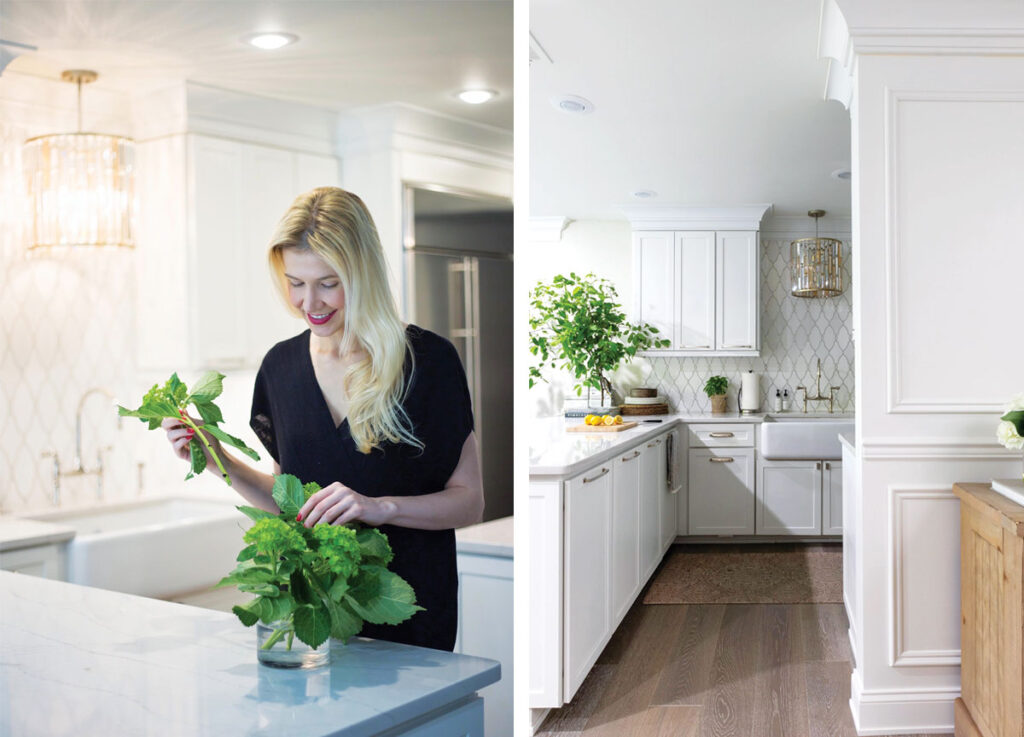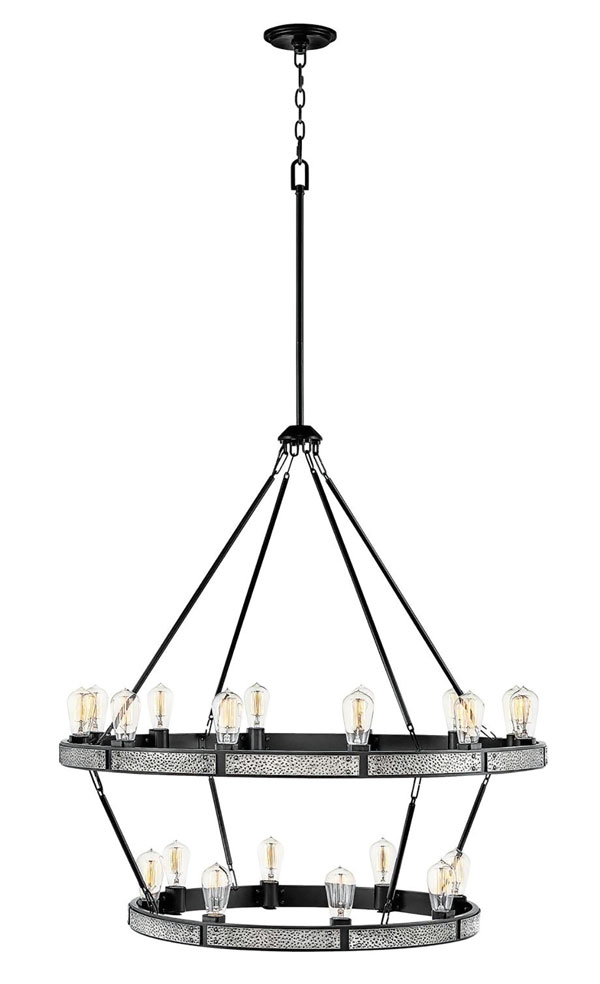Conversations with Kate: Casting Light
| Interviewer Ren MillerTips on choosing fixtures that enhance your everyday life

Kate Rumson is shown in her current kitchen, which includes recessed lighting and Hinkley’s Gemma chandelier over the sink.
Many of us choose light fixtures based on how they look. Equally important, however, is how they function. Kate Rumson sought advice from Lauren Lovett, product director and lighting expert from Hinkley, a leading lighting manufacturer and designer, in planning the home she is building in central New Jersey. Rumson is the founder and creative director of The Real Houses of Instagram (@the_real_houses_of_ig). Design NJ has been following the planning and construction of her new home in this column. In this issue, Rumson and Lovett share insights into making smart lighting choices.
Ren: How do I determine what types of lighting I need for different rooms?
Kate: Consider how you intend to use each space, how much light you need and what mood you want to set. See how natural light plays in the room and how you can support that with artificial light at different times of the day.
Lauren: I recommend layering different types of lighting to create the right balance. Every room can benefit from a combination of three forms of lighting: ambient, task and accent. In the kitchen, for example, recessed fixtures in the ceiling provide excellent ambient light, while pendants over the island serve as task lights to illuminate the countertop. LED under-cabinet fixtures also make great task lighting for countertops. Wall sconces are good for accent lighting. In the dining room, where you don’t need bright light, use a statement chandelier over the table. On the other hand, for the bathroom vanity, I like bright, 3000K LED lights. Plug-in sconces with on/off switches are great task lighting for reading nooks or over bedside tables.

The Everett chandelier, black with hammered-polished-nickel trim, will hang in her new foyer. Rumson is making sure her new home will have adequate amounts of all three types of lighting: ambient, task and accent.
Ren: Is there a general rule about how big pendant lights and chandeliers should be in foyers, dining rooms and kitchens?
Kate: The trend in lighting is going larger scale, but it’s still important to choose the right size to fit the space. I tend to go for oversized lighting — it’s the best way to create an impactful and memorable space.
Lauren: Over a typical kitchen island, I recommend a pair of 16-to-18-inch pendants. For the dining room, larger, 30-inch chandeliers or pendants often work well. Try to keep the chandelier’s diameter within 12 to 15 inches from the edge of the table. Linear chandeliers have been taking off recently too. The length of a linear chandelier should be a third of the length of the table. Because the foyer sets the tone for the rest of your home, that’s a great place to make a statement with your lighting. Standard practice for sizing a chandelier is to measure the length and width of the room in feet, then convert to inches. In rooms with extra-high ceilings, you can add a few inches to the chandelier diameter. As far as hanging height, for standard 8-foot ceilings, the fixture should be 7 feet above the floor. For a two-story foyer, hang the chandelier where the second story of the home begins or center it in the frame of a window as a focal point.
Ren: How far above my dining table should my light be?
Lauren: Assuming your ceilings are standard height, hang your chandelier 34 to 36 inches above the table. This will maintain your line of sight, so your chandelier won’t block views of the people you’re dining with. One trend we’re seeing in dining rooms in place of a traditional chandelier is using larger-scale, decorative flush mounts or semi-flush-mount fixtures over the table.
Ren: I want my kitchen to have bright light. What’s a good guideline for recessed lights to guarantee ample brightness but not look like an airport runway?
Lauren: As a general rule, space 4-inch can lights 4 feet apart and 6-inch cans 6 feet apart. Because of its low-profile design, recessed lighting is a great place to take advantage of LED technology.
Kate: I recommend having recessed lights on a dimmer so you can adjust the level of light. It is also a good idea to pair them with pendants, sconces and chandeliers to create a balanced, layered effect.
Ren: How far from a mirror or piece of art should sconces be?
Lauren: Wall sconces next to a mirror make great task lights. Generally, mount them 6 inches from the edge of the mirror or piece of art. At the vanity, hang sconces 60 to 65 inches from the floor. To prevent unflattering shadows, the height of the sconces should be just about eye level.
Ren: With all the types of lightbulbs available these days, which type(s) do you recommend considering brightness, color temperature and energy efficiency?
Lauren: Lightbulb technology has changed drastically in recent years. While incandescent, compact fluorescent and halogen bulbs are all still available, LED technology has risen to the forefront. And while LED lighting is incredibly energy efficient and practical, it’s really important to consider color temperature when choosing an LED bulb. For areas where you want bright, white lighting—kitchens, bathrooms, hallways, laundry rooms, closets—I recommend 3000K. To create a warmer environment for living rooms and dining rooms, 2700K is best.
Ren: Where do you like to have the ability to dim the lights?
Kate: I love having the ability to adjust light levels and plan on having dimmers in almost every room in our new home.
